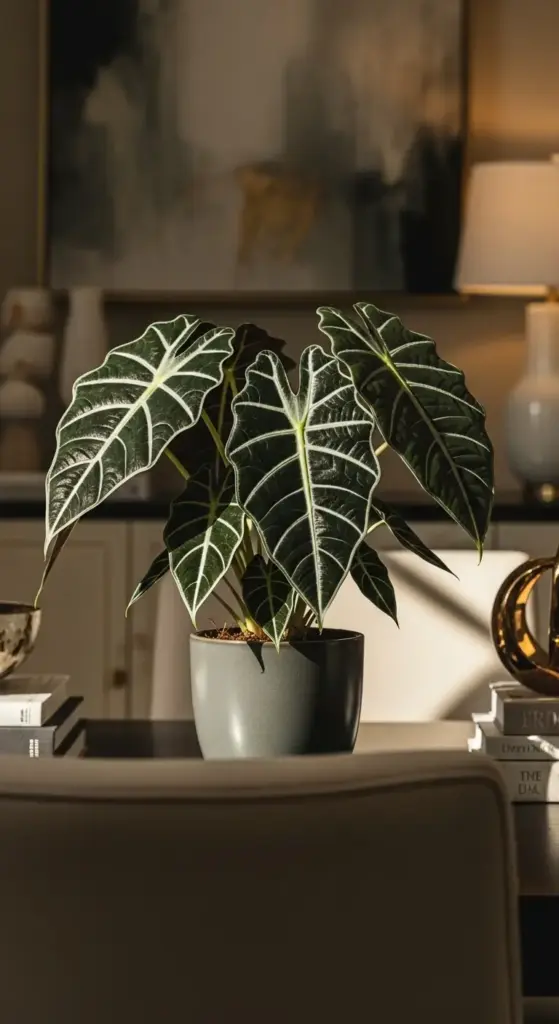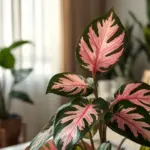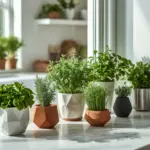4. Alocasia ‘Black Velvet’

The first time I brought home an Alocasia Black Velvet, my roommate literally did a double-take and asked if I’d bought a fake plant. Those leaves are so impossibly dark and velvety, they don’t look real.
I’m talking about foliage so dramatic it makes other plants look boring.
This little beauty has become my go-to conversation starter. Every single person who visits my apartment stops dead in their tracks when they see it.
Foliage That’s Pure Living Art
I’ve owned a lot of plants over the years, but nothing – and I mean nothing – has the visual impact of Alocasia Black Velvet leaves. They’re this deep, almost black-green color with the most incredible velvety texture.
The contrast between the dark leaves and bright white veining is absolutely stunning.
What really gets me is how the leaves seem to absorb light rather than reflect it. It creates this moody, sophisticated vibe that instantly elevates whatever room it’s in.
I’ve got mine on my dining room sideboard, and it’s become the focal point of the entire space. People literally rearrange themselves at dinner parties to get a better view of it.
The compact size is perfect too – mine’s been happy in the same 6-inch pot for over a year, so it won’t take over your space like some of those monster alocasias.
Humidity Hacks That Actually Work
Okay, let’s talk about the elephant in the room – alocasia humidity requirements. Everyone makes it sound like you need to turn your home into a tropical rainforest.
Here’s what actually works without buying expensive equipment.
I group my Black Velvet with other plants on a large tray filled with pebbles and water. The evaporation creates a nice microclimate without any fancy humidifiers.
My favorite hack? I keep a small bowl of water next to the plant and drop in a few decorative stones. It looks intentional, adds humidity, and costs basically nothing.
During winter when my heating system dries everything out, I’ll run a hot shower and bring the plant into the bathroom for 20 minutes. Sounds weird, but it works like magic.
The key is consistency rather than perfection. My apartment probably hovers around 50% humidity, which isn’t ideal but totally workable with these little tricks.
Seasonal Care That Keeps It Happy Year-Round
This is where I made my biggest mistakes initially – treating my Alocasia Black Velvet the same way all year long.
These plants have definite seasonal preferences that you can’t ignore.
Spring and summer are growth seasons. I water more frequently (when the top inch is dry), and I actually move mine closer to my east-facing window for stronger light.
But here’s the thing about winter care – this plant basically goes dormant. I learned this the hard way when I kept my regular watering schedule and nearly killed it with root rot.
Winter watering happens maybe every 2-3 weeks, and I moved it back from the window since the light is weaker anyway.
The leaves might look less vibrant in winter, but that’s totally normal. Don’t panic and start fertilizing or changing everything – just ride it out.
Photography Tips for Social Media Gold
I’m not even kidding when I say my Alocasia Black Velvet posts get triple the engagement of my other plant content. Those dark, velvety leaves are basically Instagram catnip.
The secret is all about lighting and contrast.
Natural light is everything with this plant. I photograph mine in the morning when soft light hits it from the side, creating gorgeous shadows that highlight the leaf texture.
Never use flash – it completely washes out that beautiful dark coloring and makes the leaves look flat.
My best shots happen when I place a white or light-colored object behind the plant. The contrast makes those dark leaves pop like crazy.
For close-up shots, try misting the leaves lightly first. The water droplets catch the light and really show off that velvety texture that makes this plant so special.
Troubleshooting Before Disaster Strikes
Let me save you from the mistakes I made during my first year with this plant. Alocasia Black Velvet problems are usually preventable if you know what to watch for.
Yellow leaves are almost always overwatering – I learned this after losing two leaves to my overzealous watering schedule.
Brown leaf edges? That’s usually low humidity or inconsistent watering. Don’t just increase watering though – check your humidity situation first.
The biggest red flag is mushy stems. If you catch this early, you can often save the plant by reducing water and improving air circulation.
Here’s something nobody tells you – spider mites love this plant. Those dark leaves make the tiny webs really obvious, so check regularly. A quick shower usually takes care of minor infestations.
If your plant goes completely dormant and loses all its leaves, don’t throw it away! Keep the soil barely moist and wait – mine came back from what looked like certain death after three months.
Think you’re ready for a plant that’s literally worth its weight in gold? Click “next” to discover the Philodendron Pink Princess – the variegated beauty that’s caused bidding wars and has people paying mortgage-level prices for a single cutting!









GIPHY App Key not set. Please check settings